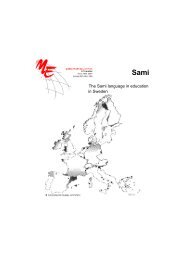Multilingual Early Language Transmission (MELT) - Mercator ...
Multilingual Early Language Transmission (MELT) - Mercator ...
Multilingual Early Language Transmission (MELT) - Mercator ...
Create successful ePaper yourself
Turn your PDF publications into a flip-book with our unique Google optimized e-Paper software.
1.2.1 Guide for pre-school practitioners<br />
One of the deliverables of the <strong>MELT</strong> project is a toolkit for practitioners: a guide for preschool<br />
teachers. This toolkit builds on existing initiatives and best practices in the<br />
participating regions, such as the book “<strong>Language</strong> Strategy for Day Care Centres” written by<br />
Gammelgård (2008), which focuses on tools for creating language strategies for day care<br />
centers. The toolkit includes guidelines, practical examples, lesson plans, and theory of<br />
language development of children aged 0-4 years. The toolkit has been translated into the<br />
eight languages of the four regions (Welsh-English, Swedish-Finnish, Breton-French, and<br />
Frisian-Dutch).<br />
In the school year 2010-2011, several practitioners (about 40 practitioners per region) in the<br />
four minority regions have implemented and tested the toolkit for practitioners. During this<br />
year the <strong>MELT</strong>-mentors visited a number of pre-school institutions. During these visits the<br />
use of the toolkit in practice is evaluated. Based on the evaluation forms and Skype meetings<br />
of the mentors the decision was made to update and restructure the toolkit. This included<br />
changing the toolkit into a guide: a binder folder with bilingual (both languages; the minority<br />
and majority language on one page) language topics sections, including theory and examples<br />
of language activities. This Guide is intended for the whole pre-school setting: the pre-school<br />
practitioners in nurseries, playgroups, day care centers and other pre-school professionals<br />
dealing with bilingualism and young children from 0 - 4 years. They can use this Guide to give<br />
them ideas to create a supportive and rich language environment (in the day care) for<br />
children, aiming to make language work as an integral part of pre-school activities during the<br />
day. Pre-school teams can develop linguistic awareness and promote the minority language<br />
and multilingualism within their pre-schools. Practitioners of the pre-school institutions can<br />
work with this Guide for a longer period, for example during one school year, and go through<br />
one section at the time. Practitioners may also use this Guide in their own way, in sequential<br />
order as a portfolio for personal growth.<br />
The title of the Guide is: “<strong>Multilingual</strong>ism for children's everyday life. A guide for<br />
practitioners working with very young children.” The Guide consists of nine sections, the first<br />
eight sections follow the same structure. Each section includes a theoretical background,<br />
suggestions and tips for daily work, and issues for reflection and development. The ninth<br />
section contains a number of examples of the language enriching activities.<br />
The sections in the Guide are intended to give an answer to questions of practitioners such<br />
as: How can I be a linguistic model for the children? How can I collaborate with the parents<br />
on linguistic matters? How can observe the children’s language and its development be<br />
observed? How can I make a rich language environment for children? What kind of language<br />
activities are there for children and how should I organise these activities?<br />
The content of the Guide for pre-school practitioners is:<br />
- Introduction<br />
- Section 1: Adults as linguistic role models<br />
- Section 2: Collaboration with parents on linguistic matters<br />
- Section 3: Everyday situations and the physical environment<br />
- Section 4: Suggestions for observing and recording children’s language<br />
- Section 5: Working with themes, and emphasis on linguistic factors<br />
13



